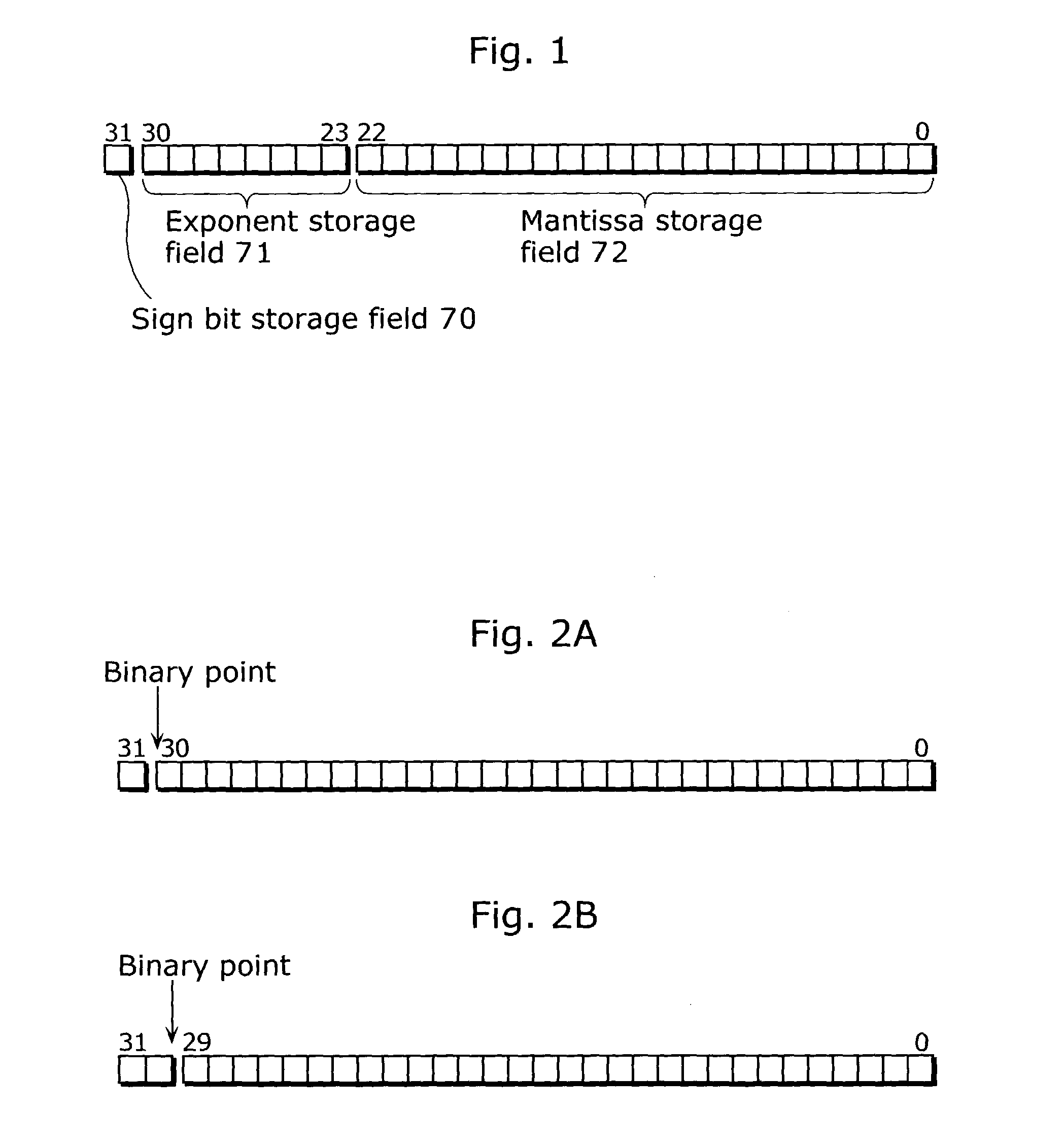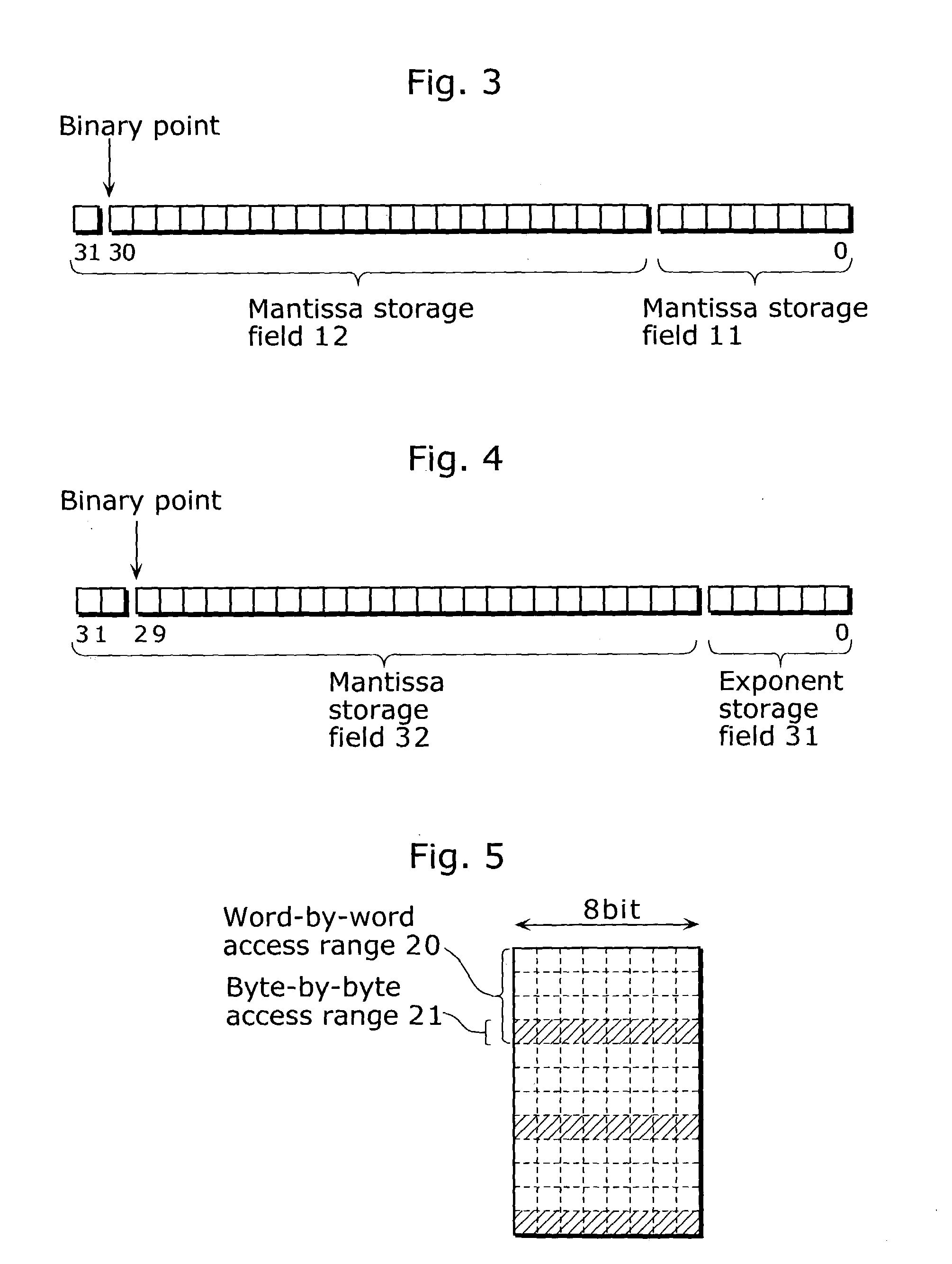Floating point number storage method and floating point arithmetic device
a technology of floating point and arithmetic device, which is applied in the direction of instruments, computation using denominational number representation, computation using non-denominational number representation, etc., can solve the problems of enormous processing volume, enormous processing volume, and enormous processing volume, and achieve the effect of extremely high practical value of the present invention
- Summary
- Abstract
- Description
- Claims
- Application Information
AI Technical Summary
Benefits of technology
Problems solved by technology
Method used
Image
Examples
first embodiment
[0061] (First Embodiment)
[0062] The floating point number storage method in the first embodiment of the present invention will be explained below with reference to drawings.
[0063] FIG. 3 is a diagram showing a bit field of a real number x to be stored by the floating point number storage method in the first embodiment of the present invention. This bit field includes an exponent storage field 11 and a mantissa storage field 12.
[0064] In the exponent storage field 11, the value n is stored as an 8-bit integer where the real number x is represented by a*2{circumflex over ( )}n. The value is represented in two's complement, for instance. In the mantissa storage field 12, the value x is stored in 24 bits where the real number x is represented by a*2{circumflex over ( )}n. The value is represented by a fixed point number whose binary point is fixedly placed. In the present embodiment, the value a is normalized so as to be within the range of -1.about.+1. Therefore, this 24-bit structure,...
second embodiment
[0094] (Second Embodiment)
[0095] Next, the floating point arithmetic device according to the second embodiment of the present invention will be explained with reference to the figures.
[0096] FIG. 6 is a block diagram showing the structure of a floating point arithmetic device 100 in the second embodiment of the present invention. In the present embodiment, the floating point arithmetic device 100 for multiplying floating point numbers x and y will be explained. Here, it is assumed that the floating point number storage format complies with the format as mentioned in the first embodiment. Since multiplication is performed according to the expression
X*y=a*b*(2{circumflex over ( )}(n+m)), where x=a*(2{circumflex over ( )}n) and y=b*(2{circumflex over ( )}m),
[0097] multiplication of mantissas and addition of exponents are the main arithmetic.
[0098] The floating point arithmetic device 100, which is an arithmetic circuit for multiplying two real numbers of 32 bits long and outputs the mu...
third embodiment
[0138] (Third Embodiment)
[0139] Next, the floating point arithmetic device in the third embodiment of the present invention will be explained with reference to the figures.
[0140] FIG. 12 is a block diagram showing the structure of the floating point arithmetic device in the third embodiment of the present invention. The floating point arithmetic device 500, which is an arithmetic device for converting floating point numbers into integers, includes the first register 101, a subtracter 501 and a bit shifter 502.
[0141] The first register 101, which is same as the register in the first embodiment, holds a real number x having a mantissa storage field of the upper 24 bits and an exponent storage field of the lower 8 bits when the real number x is represented by a*(2{circumflex over ( )}n) where the mantissa is a and the exponent is n.
[0142] The subtracter 501 subtracts x from a predetermined value C when the value of the lower 8 bits stored in the first register 101 is x, and the bit shi...
PUM
 Login to View More
Login to View More Abstract
Description
Claims
Application Information
 Login to View More
Login to View More - R&D
- Intellectual Property
- Life Sciences
- Materials
- Tech Scout
- Unparalleled Data Quality
- Higher Quality Content
- 60% Fewer Hallucinations
Browse by: Latest US Patents, China's latest patents, Technical Efficacy Thesaurus, Application Domain, Technology Topic, Popular Technical Reports.
© 2025 PatSnap. All rights reserved.Legal|Privacy policy|Modern Slavery Act Transparency Statement|Sitemap|About US| Contact US: help@patsnap.com



